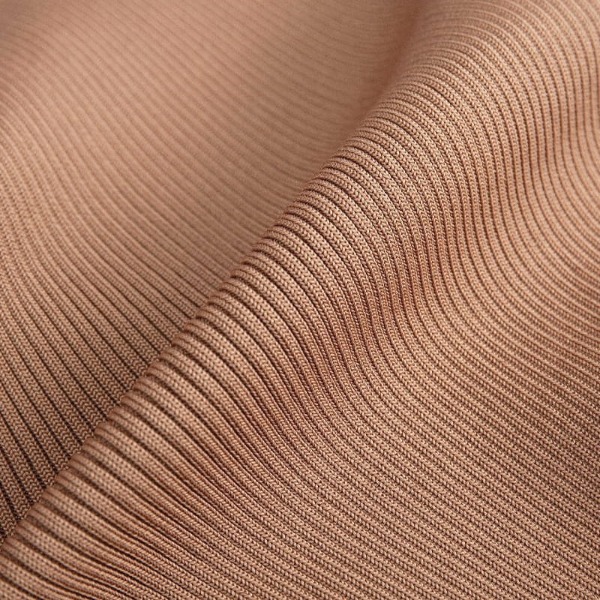Introduction
The textile industry has always been a fascinating blend of art, science, and functionality. From ancient weaving traditions to the digital knitting technologies of today, fabrics reflect cultural expression as much as technological innovation. Among the vast spectrum of textiles, Ribbed Fabrics have gained remarkable prominence.
Distinguished by their vertical ridges, or “ribs,” Ribbed Fabrics are produced by alternating knit and purl stitches in a structured sequence. This seemingly simple modification of knitting creates a cloth with extraordinary elasticity, recovery, and visual texture. Unlike flat knits or woven materials, ribbed textiles provide both resilience and comfort, making them suitable for an array of applications ranging from fashion apparel and home furnishings to industrial textiles and sports products.
This article takes a deep dive into the world of Ribbed Fabrics. We will explore their construction, types, material variations, scientific properties, diverse applications, care methods, and even their future role in sustainable design. By the end, it will become clear why these fabrics are far more than just decorative textures—they are integral to both style and function.
The Science and Craft of Ribbed Fabrics
How Ribbed Structures Are Formed
The defining characteristic of Ribbed Fabrics lies in their knitting technique. By alternating knit and purl stitches, the fabric forms raised vertical ridges (ribs) and recessed channels. This structural interplay creates a surface that is both flexible and durable.
When the fabric is stretched, the looped yarns temporarily extend, but the elasticity inherent in the stitch formation ensures that the material recovers its original shape once tension is released. This is why Ribbed Fabrics are ideal for garments requiring snug fits, such as cuffs, waistbands, or body-hugging apparel.
From a materials science perspective, the strength of ribbed fabrics depends on both the fiber type and the knitting density. The denser the rib pattern, the more durable and resilient the fabric becomes.
Historical Development
The concept of ribbed textiles can be traced back to early knitting traditions in Europe, where they were commonly used in socks, gloves, and cuffs for elasticity. With the invention of industrial knitting machines during the Industrial Revolution, ribbed knits became easier to produce at scale. In the 20th century, the introduction of synthetic fibers such as polyester, acrylic, and nylon further expanded the versatility of Ribbed Fabrics. Today, they are among the most widely used knit structures globally.
Types of Ribbed Fabrics
Not all ribbed textiles are identical. They vary by stitch arrangement, thickness, and purpose. Below are the most common weave types.
1x1 Rib
This is the simplest ribbed structure, alternating one knit stitch with one purl stitch. The result is a fine, subtle ribbing with excellent elasticity. It is commonly used in lightweight tops, cuffs, collars, and form-fitting garments.
2x2 Rib
By alternating two knit stitches with two purl stitches, the texture becomes more pronounced and thicker. The elasticity is slightly reduced compared to 1x1, but the durability increases. This type is popular in sweaters, cardigans, and casual wear.
3x3 Rib
Characterized by three knit stitches followed by three purl stitches, this creates a chunky, bold ribbing. It is often used in winter knitwear such as scarves, beanies, and heavy sweaters.
Advanced Variations
Modern textile engineering has produced numerous rib variants, such as uneven ribs (1x2, 2x3), double-face ribs, and engineered ribs with integrated stretch fibers like elastane. These variations allow for even more diverse applications.
Table 1: Comparison of Rib Weave Types
| Rib Type | Texture | Elasticity | Thickness | Common Applications |
|---|---|---|---|---|
| 1x1 Rib | Fine, subtle | Very high | Light | T-shirts, underwear, cuffs |
| 2x2 Rib | Medium definition | High | Medium | Sweaters, cardigans, socks |
| 3x3 Rib | Bold, chunky | Moderate | Thick | Scarves, beanies, coats |
| Double Rib | Symmetrical, dense | Good | Variable | Premium knitwear, technical garments |
Materials Used in Ribbed Fabrics
The properties of Ribbed Fabrics depend not only on the knitting pattern but also on the fibers used. Different materials impart unique qualities such as warmth, durability, or softness.
Synthetic Fibers
- Polyester: Known for its strength, wrinkle resistance, and colorfastness. Polyester rib fabrics are durable and ideal for everyday clothing.
- Nylon: Extremely resilient and abrasion-resistant, making it excellent for sportswear and performance apparel.
- Acrylic: A lightweight synthetic that mimics wool’s warmth and softness while being hypoallergenic.
Natural Fibers
- Wool: Provides exceptional insulation and breathability, making wool rib fabrics popular for winter wear.
- Cotton: Soft, breathable, and skin-friendly, widely used in casual apparel and household textiles.
- Bamboo Fiber: Valued for its sustainability, antibacterial properties, and eco-friendly production.
Table 2: Material Properties in Ribbed Fabrics
| Material | Durability | Elasticity | Warmth | Comfort | Best Use Cases |
|---|---|---|---|---|---|
| Polyester | High | Medium | Medium | Medium | Casual wear, outerwear |
| Nylon | High | High | Low | Medium | Sportswear, activewear |
| Acrylic | Medium | Medium | High | High | Sweaters, scarves |
| Wool | Medium | Medium | Very high | High | Winter knitwear |
| Cotton | Medium | Medium | Medium | Very high | T-shirts, loungewear |
| Bamboo Fiber | Medium | Medium | Medium | High | Sustainable fashion |
Applications of Ribbed Fabrics
Fashion and Apparel
In the fashion industry, Ribbed Fabrics are prized for their ability to enhance silhouette and provide comfort. Designers use ribbed knits for bodycon dresses, casual tops, sweaters, skirts, and even eveningwear. Their three-dimensional structure adds visual intrigue, elevating otherwise simple garments.
Sportswear and Functional Textiles
Elasticity and durability make ribbed knits suitable for activewear. Yoga leggings, compression tops, and running gear benefit from the stretch and recovery that ribbed fabrics provide. The material allows garments to move with the body while retaining shape.
Household and Home Décor
Beyond apparel, ribbed textiles appear in cushion covers, throws, and bedding. The ribbed texture introduces a tactile quality that enhances comfort and aesthetics in interior design.
Industrial and Medical Use
Ribbed Fabrics are also applied in industrial settings. Their durability and elasticity make them useful in braces, orthopedic supports, and protective gear. Some engineered ribs are used in filtration textiles, thanks to their structural resilience.
How to Choose the Right Ribbed Fabrics
Selecting the correct rib knit depends on the intended application.
- For minimal, sleek garments: Choose 1x1 rib in cotton or polyester.
- For cozy, thicker apparel: Opt for 3x3 rib in wool or acrylic.
- For activewear: Nylon-based or polyester blends with spandex work best.
- For sustainable fashion: Consider bamboo-based rib fabrics or organic cotton ribs.
When evaluating fabrics, key qualities to check include elasticity (ability to stretch and recover), softness, density of the weave, and colorfastness after washing.
Caring for Ribbed Fabrics
Proper care ensures rib knits maintain their elasticity and shape.
- Washing: Cold water washing is recommended to avoid shrinkage. Use gentle detergents.
- Drying: Air-dry flat to prevent distortion; avoid machine drying, which can damage fibers.
- Storage: Fold rather than hang heavy rib knit garments to avoid stretching at the shoulders.
Well-maintained Ribbed Fabrics can last for years, retaining their comfort and aesthetics.
Sustainability and Future Trends
As sustainability becomes central to the textile industry, Ribbed Fabrics are adapting as well. Increasingly, manufacturers are using recycled polyester, organic cotton, and bamboo fibers to create eco-friendly rib knits.
Advances in textile technology are also shaping the future of rib fabrics. 3D knitting allows for seamless garments with minimal waste, while smart textiles integrate temperature regulation or moisture sensing into ribbed structures. The next generation of Ribbed Fabrics will likely merge aesthetics, comfort, and intelligent functionality.
Conclusion
Ribbed Fabrics are more than just decorative textiles. Their unique structure provides elasticity, comfort, and durability, making them indispensable in modern fashion, sportswear, home goods, and even industrial applications. By understanding the different weave types, materials, and proper care methods, one can fully appreciate the versatility of these fabrics.
Looking forward, with sustainability and smart technology driving innovation, Ribbed Fabrics are poised to remain at the forefront of textile design. They represent a rare balance of beauty, function, and adaptability—a fabric type that has stood the test of time and will continue to evolve with future generations.


 English
English Español
Español






